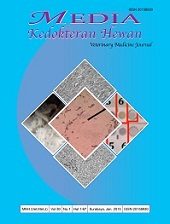Detection of Antibiotic Resistance Salmonella Sp Isolated from Layer Chicken Farm in Sesaot West Lombok
Downloads
Antibiotic resistance is a global problem related to human and animal health. Antibiotic resistance occurs when bacteria acquire a resistant gene that allows them to survive when exposed to the antibiotic. Production animals and their production environment are considered as a reservoir for the emergence of resistant bacteria that transfer to humans either directly or indirectly. Narmada Subdistrict in West Lombok is one of the districts that have a large population of poultry. One of the infectious diseases that often attacks poultry and is treated using antibiotics is Salmonella sp. This study aims to determine the data on antibiotic resistance in Salmonella sp. This resistance data can be used as an effort to prevent antibiotic resistance against Sallmonella sp bacteria in layer chicken farms in Sesaot, West Lombok. This research using eight Salmonella sp. isolates, they were tested with antibiotics PenicillinG, Tetracycline and Oxytetracycline. Bacterial resistance test was carried out after the results obtained from the identification of bacteria, Salmonella sp. The results obtained from eight Salmonella sp isolates tested for antibiotic resistance, antibiotics were categorized as susceptible to Penicillin G (75%), Oxytetracycline (12.5%), and Tetracycline (12.5%). Antibiotics were categorized as intermediates consisting of Penicillin G (0.0%), Oxytetracyline (12.5%), and Tetracycline (50%). and Antibiotics categorized as resistant consisted of Penicillin G (25%), Oxytetracycline (75%), and Tetracycline (37.5%).
[Kementan] Kementerian Pertanian. 2019. Situasi saat ini dan kebijakan pemerintah tentang Antimicrobial Resistance (AMR). Jakarta. Disektor Peternakan dan Kesehatan Hewan. Disampaikan dalam Studium Generale AMR di Menara 165 Jakarta.
Agustin, A.L.D. 2018. PF-10 Antimicrobial Resistance of Bacterial Strains Isolated from Layer Chicken on Poultry Village in North Lombok, West Nusa Tenggara, Indonesia. Hemera Zoa.
Agustin, A.L.D and Kholik. 2019. Resistance antibiotic on salmonella sp. Isolated from layer chiken in north lombok. https://www.researchgate.net/publication/346028483_RESISTANCE_ANTIBIOTIC_ON_Salmonella_sp_ISOLATED_FROM_LAYER_CHICKEN_IN_NORTH_LOMBOK
Beukes, C.C. 2011. A Study on the Relationship Between Between Improved Patient and Compliance with antibiotic use. South African society of clinical pharmacy
Beukes, C.C. 2011. A Study on the Relationship Between Between Improved Patient and Compliance with antibiotic use. South African society of clinical pharmacy
Clinical and Laboratory Standards Institute. 2017. Performance Standads for Antimicrobial Susceptibility Testing 27 Edition. West Valley Road, Suite 2500.
Djide, M.N., dan Sartini. 2008. Dasar-Dasar Mikrobiologi Farmasi. Lembaga Penerbit UNHAS. Makassar
Malinowski, J., and C.L. Horton. 2011. Themes of continuity: Commentary on "The continuity and discontinuity between waking and dreaming: A Dialogue between Michael Schredl and Allan Hobson concerning the adequacy and completeness of these notions”. International Journal of Dream Research, 4(2), 86-92.
Marshall, B.M., and S.B. Levy. 2011. Food animals and antimicrobials: imacts on human health. Clin Microbiol Rev 24: 718-733
Martin, S.W., A.H. Meek and P. Willeberg, 1987. Veterinary Epidemiology. Principle and Methods. First edition. Lowa State University Press/Ames. Lowa. USA
Noor SM, dan Poelongan M. 2005. Pemakaian antibiotik pada ternak dan dampaknya pada kesehatan manusia. Prosiding Lokakarya Nasional Keamanan Pangan Produk Peternakan. Bogor (ID): Puslitbang Peternakan.
O'Neill, J. 2016. Tackling drug-resistant infections globally: Final report and recommendations. London, UK. Wellcome trust and HM Government
Thaha, A.H. 2017. Gambaran klinis dan prevalensi salmonellosis pada ayam ras petelur di desa Tanete kec. Maritenggae kabupaten Sidrap. Jurnal Ilmu dan Industri Peternakan, 3(1).
Utami, E.R. 2011. Antibiotika, Resistensi, dan Rasionalitas Terapi. Fakultas Sains dan Tekhnologi UIN Maliki. Malang.
Vandepitte, J. 2010. ProsedurLaboratorium Dasar untukBakteriologiKlinis. EGC. Jakarta.
WHO. 2009. Improving Health System and Service for Mental Health: WHOLibraryCataloguing-in PublicationData.http://apps.who.int/iris/bitst ream/10665/44219/1/9789241598774_eng.p
Yuwono. 2012. Staphylococcus intermedius dan Methicilin-Resistant Staphylococcus intermedius (MRSI). Palembang: Departemen Mikrobiologi FK Unsri.

Veterinary Medicine Journal by Unair is licensed under a Creative Commons Attribution-ShareAlike 4.0 International License.
1. The Journal allows the author to hold the copyright of the article without restrictions.
2. The Journal allows the author(s) to retain publishing rights without restrictions
3. The legal formal aspect of journal publication accessibility refers to Creative Commons Attribution Share-Alike (CC BY-SA).





11.jpg)







11.png)













